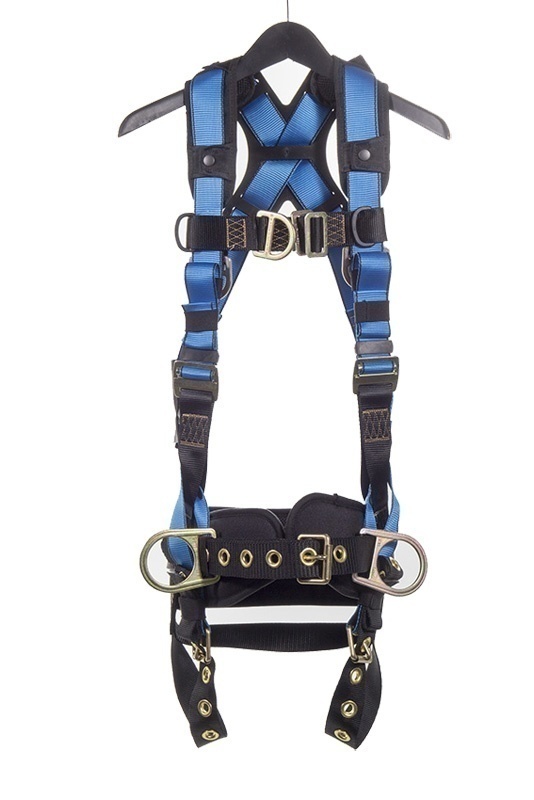RF 101
 When it comes to working in the telecom industry, it’s no secret that there are a wide variety of different dangers. Most dangers can be seen – whether it has to do with falling, having things fall on you, etc. But not all dangers are visible with the human eye – or even any human sense. This week our Gear Experts® are going to break down the hidden danger of RF.
When it comes to working in the telecom industry, it’s no secret that there are a wide variety of different dangers. Most dangers can be seen – whether it has to do with falling, having things fall on you, etc. But not all dangers are visible with the human eye – or even any human sense. This week our Gear Experts® are going to break down the hidden danger of RF.
More Than Meets the Eye
RF, or radio frequency, is any electromagnetic wave frequency. In the telecom industry, this is the energy that is emitted from radios or telecommunications equipment. Electromagnetic wave frequencies can’t always be seen or heard, but they are absorbed by your body and, if overexposed, can cause serious harm.
The Dangers of RF
So, now that we know what RF is and that just because we can’t see, hear, or otherwise sense, it doesn’t mean it isn’t dangerous. Let’s cover some of the effects of RF exposure. The primary effect is heating – think of it like a microwave oven which uses electromagnetic waves to heat food from the inside out. Keep in mind, that while a microwave does use electromagnetic waves to cook food, it is a very large amount of power being concentrated into a tiny steel box. Most telecom related RF situations will not be nearly as drastic as a microwave oven. However, the basic concept is the same. When the electromagnetic waves are absorbed by your body they heat it up from the inside out and you begin to experience RF sickness.
Symptoms of RF Sickness
RF Sickness won’t be noticed by most people right away. In fact, some people may never even realize they have it, which can cause added risk. The reason people don’t always know they have RF sickness is because the primary symptom is heat. It can be difficult to determine whether you may have RF sickness, or you simply haven’t been drinking enough water and might be dehydrated. With that being said, the symptoms of RF Sickness are most commonly compared to having a fever – making it even more difficult to detect.
Effects of RF Sickness
RF heats your body from the inside out. That means that as you are exposed to it, it is raising your core temperature. It’s not the same as standing next to a heater where you would feel the heat on your skin rather the heat would begin radiating outward from your core. As your core begins to heat and your body begins to lose the ability to prevent your temperature from rising you can start to experience heat stress. The symptoms of heat stress include rash, cramps, dizziness, headache, nausea, confusion, heavy sweating, weakness, seizures, and unconsciousness. We’ve covered heat stress in its entirety on a previous blog post which you can find by clicking here. While all symptoms of heat stress are serious and should be treated immediately, we want to focus on confusion for just a second. Confusion also referred to as irrational behavior, can lead to costly mistakes and potentially fatal accidents. In fact, it is difficult to know if some tower fatalities were caused because of human error, or if confusion caused by RF sickness was to blame.
RF Exposure
The actual full breakdown of how the human body reacts to RF exposure can get pretty technical and is beyond the scope of a blog post. But, boiled down to its most basic explanation, our bodies are more receptive to lower frequencies. And, because of the way our bodies react to RF frequencies the way that safe exposure limits are expressed is more of a bell curve rather than a straight line. Beyond that, RF exposure tracking uses a 6-minute averaging rule.
6-Minute Averaging Rule
What the 6-Minute Averaging Rule means is that over the course of 6 minutes, your average exposure level cannot exceed that of 100% of the FCC limits. Essentially, what this means is that you could have a brief period where you are at 150% of the FCC limits, but then for the next few minutes, you are only at 25%. This is acceptable because the average exposure level over the course of 6 minutes is below 100%.
FCC RF Limits
As we mentioned above, the FCC has outlined limits for RF exposure (OET65) that are implemented using the 6-minute averaging rule (0.1-hour periods). The FCC limits vary over frequency as they specifically take into account how your body interacts with and absorbs RF. As an example, at 100 MHz, the maximum possible exposure is 1 mW/cm2, and at 3 GHz it is 5 mW/cm2. Correctly measuring all RF sources present referenced to the FCC limits in terms of combined percentage is accomplished using a broadband shaped RF probe response able to measure both the Electric (E) and Magnetic (H) fields. This combined exposure over frequency, as a percentage is what allows you to take action when levels exceed the safe working limits.
Limiting RF Exposure
When it comes to limiting RF exposure there are two main components. The first component is proper training while the second component is a safety monitor.
Proper Training
Just like everything in the tower industry, training is an important part of ensuring safety. We have partnered with industry-leading training companies like Safety LMS to offer an online Fundamentals of RF/EME Radiation course. This course was designed to help ensure that employees can recognize the hazards of RF that exist on tower sites – whether that is a tower or a rooftop.RF Monitors
An RF monitor complements training. After all, being trained to understand and handle a hazard is great, but when you cannot detect the hazard with your senses, it’s kind of hard to make sure you’re not exceeding safe exposure limits. One reason why an RF monitor is so important is that it is a shaped probe/shaped response device. What that means is that it has the ability to account for all RF frequencies in the surrounding area (like a rooftop with multiple different types of antennas) and calculate the amount of exposure from each. It then combines those numbers and bounces that against the safe working limits. With personal RF monitors like the FieldSENSE 2.0 Personal RF Monitor you can rest assured that you will be able to accurately detect RF. We covered the FieldSENSE 2.0 Personal RF Monitor in a previous blog post which you can read by clicking here. We recently featured Max Birch, the lead engineer for FieldSENSE, as our guest on our podcast: Gear Up with Gear Experts. Max dropped some knowledge bombs about RF and helped break down some of the complicated parts of RF awareness and safety. You can find that podcast episode by clicking here. If you have any questions about RF safety or RF Monitors, click here to contact one of our Gear Experts®. → Click here to see our blog post about the FieldSENSE 2.0 Personal RF Monitor → Click here to view the FieldSENSE 2.0 Personal RF Monitor → Click here to listen to our RF Safety podcast episode **The content of this blog is not intended to replace proper, in-depth training. Manufacturer’s instructions must also be followed and reviewed before any equipment is used.FieldSENSE: Guide to Recalibration
Gear Up with Gear Experts: The Podcast
 If you haven’t already checked out Gear Up with Gear Experts, our podcast dedicated to at-height, industry, and construction, it is available for download! You can find it on all major podcast listening platforms like Apple Podcasts, Spotify, Google Play Music, + your favorite podcatcher of choice. And, you can head on over to gearexperts.com to follow us on social media, check out our detailed show notes, and sign up for updates.
If you haven’t already checked out Gear Up with Gear Experts, our podcast dedicated to at-height, industry, and construction, it is available for download! You can find it on all major podcast listening platforms like Apple Podcasts, Spotify, Google Play Music, + your favorite podcatcher of choice. And, you can head on over to gearexperts.com to follow us on social media, check out our detailed show notes, and sign up for updates.
Get Social
Be sure to follow us on social media to keep up with everything GME Supply has going on.
Facebook | Instagram | YouTube | Twitter | LinkedIn

We’re Also on Snapchat
Simply snap or screenshot this image ↓ to follow GME Supply!













